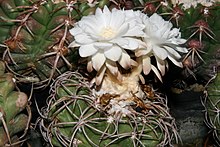| Discocactus bahiensis | |
|---|---|

| |
| Conservation status | |
 Vulnerable (IUCN 3.1) | |
| CITES Appendix I (CITES) | |
| Scientific classification | |
| Kingdom: | Plantae |
| Clade: | Tracheophytes |
| Clade: | Angiosperms |
| Clade: | Eudicots |
| Order: | Caryophyllales |
| Family: | Cactaceae |
| Subfamily: | Cactoideae |
| Genus: | Discocactus |
| Species: | D. bahiensis |
| Binomial name | |
| Discocactus bahiensis Britton & Rose 1922 | |
| Synonyms | |
| |
Discocactus bahiensis is a species of Discocactus from Brazil.
Description
Discocactus bahiensis grows solitary, with heavily spined, depressed spherical to spherical bodies that reach diameters of 8 to 18 centimeters. There are 10 to 15 ribs. The areoles are wooly have 5 to 13 backward-curved spines are up to 3 centimeters long. The prominent cephalium is formed of white wool and a few short bristles. The slender, funnel-shaped, yellowish white flowers are 4 to 5 centimeters long. The fruits are small and red.
Subspecies
- Discocactus bahiensis subsp. bahiensis
- Discocactus bahiensis subsp. gracilis P.J.Braun & Esteves
Distribution
Discocactus bahiensis is a cactus species native to the Brazilian state of Bahia at altitudes between 380 and 650 meters. Plants are found growing in limestone near rivers and flood plains.
Taxonomy
It was first described in 1922 by Nathaniel Lord Britton and Joseph Nelson Rose. The species name "bahiensis" specifically denotes its presence in Bahia, Brazil.
References
- Kew), Nigel Taylor (RBG; Assessment), Pierre Braun (Global Cactus (2010-06-04). "The IUCN Red List of Threatened Species". IUCN Red List of Threatened Species. Retrieved 2024-01-22.
- "Appendices | CITES". cites.org. Retrieved 2022-01-14.
- "Discocactus bahiensis in Tropicos".
- Anderson, Edward F.; Eggli, Urs (2005). Das grosse Kakteen-Lexikon (in German). Stuttgart (Hohenheim): Ulmer. ISBN 3-8001-4573-1.
- "Discocactus bahiensis". LLIFLE. 2013-08-04. Retrieved 2024-01-22.
External links
- [REDACTED] Media related to Discocactus bahiensis at Wikimedia Commons
- [REDACTED] Data related to Discocactus bahiensis at Wikispecies